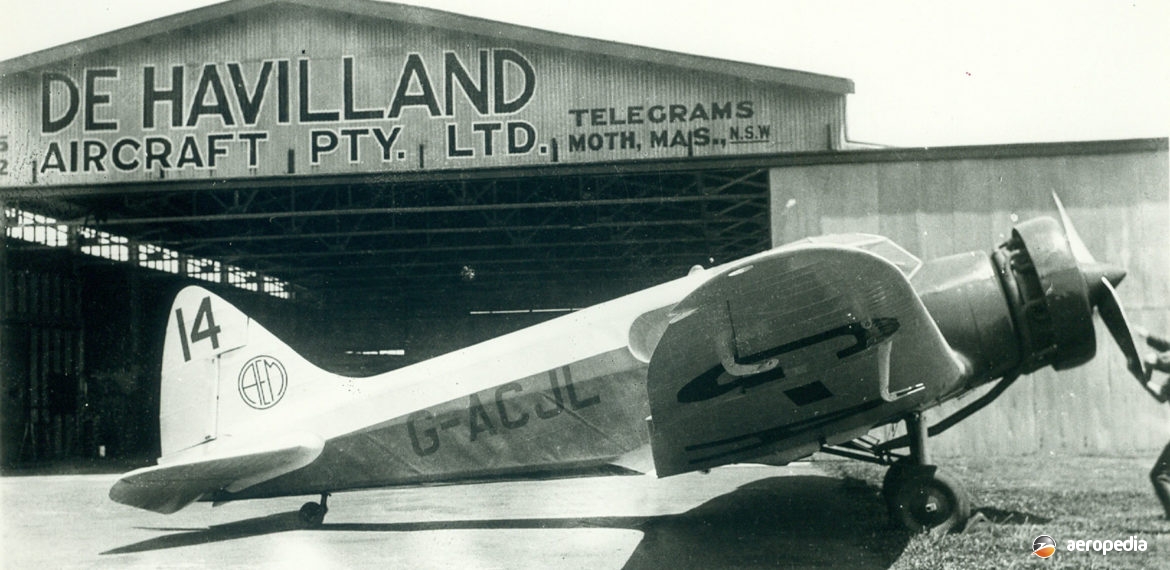Photograph:
Airspeed AS.5 Courier G-ACJL at Mascot, NSW in 1934 (Frank Walters collection)
Country of origin:
United Kingdom
Description:
Light commercial transport
Power Plant:
One 179 kw (240 hp) Armstrong Siddeley Lynx IVC seven-cylinder air-cooled radial engine
Specifications:
- Wingspan: 14.32 m (47 ft)
- Length: 8.71 m (28 ft 6 in)
- Height: 2.71 m (8 ft 9 in)
- Wing area: 23.22 m² (250 sq ft)
- Max speed: 246 km/h (153 mph)
- Cruising speed: 212 km/h (132 mph)
- Initial rate of climb: 222 m/min (730 ft/min)
- Ceiling: 4,115 m (13,500 ft)
- Range: 1,022 km (635 miles)
- Empty weight: 1,063 kg (2344 lb)
- Loaded weight: 1,769 kg (3,900 lb)
History:
The Airspeed AS.5 Courier, AS.6 Envoy, and AS.8 Viceroy series was built in some numbers by Airspeed Limited in the 1930s, the Company, founded by Neville Shute Norway and Alfred Hessell Tiltman, proposing a number of designs but settling on the AS.5 Courier in 1931, a low-wing cantilever monoplane seating five or six, and having a retractable undercarriage. The prototype, and most production aircraft, were fitted with the 179 kw (240 hp) Armstrong Siddeley Lynx engine, but later the AS.5A and AS.5B had the 228 kw (305 hp) Armstrong Siddeley Cheetah V unit, also of seven cylinders; and the AS-5J had the 261 kw (350 hp) Armstrong Siddeley Cheetah IX.
The prototype G-ABXN (c/n 7) was constructed at York in North Yorkshire, UK and first flew on 10 April 1933, being built for Sir Alan Cobham to be used in a non-stop flight to India, making its first flight at Portsmouth in the hands of G H Stainforth. Fitted with a 179 kw (240 hp) Lynx IVC radial engine, it had a fuel capacity of 1,250 litres (275 Imp gals). Four days after its first flight it crashed at Portsmouth in Hampshire and received minor damage. After repairs it was flown to RAF Martlesham Heath in Suffolk for air-to-air refuelling experiments by Cobham using two Handley Page W.10s as aerial tankers. The flight non-stop to India from Portsmouth was attempted but a forced landing was made on 24 September 1934 at Malta due to a broken throttle. The aircraft was later impressed into the RAF in June 1940 as X9127 and its subsequent fate is not known.
Another aircraft G-ACJL (c/n 10) took part in the October 1934 MacRobertson England to Australia race from Mildenhall in Suffolk to Melbourne, in Victoria coming fourth in the handicap section in a time of 100 hrs 24 mins at an average speed of 180 km/h (123 mph). It was flown by Sqdn Ldr D E Stoddart and K G Stoddart. Photographs show it was refuelled at Newcastle Waters, NT on 28 October 1934. This aircraft first flew on 27 September 1933 and was registered to Aircraft Exchange and Mart Ltd of Hanworth in Middlesex, being registered as VH-UUF to the same company at Mascot, NSW on 9 October 1935. It remained in Australia but the registration lapsed on 8 October 1936. It was shipped back to England at some time during 1936.
One other aircraft in the series was expected to come to Australia. This was the AS.8 Viceroy G-ACMU (c/n 18), a long-range variant with no windows and a large fuel tank in the cabin which was generally similar to the Envoy. It was built for Thomas Neville Stack for the 1934 Race (Race No 58) and was flown by him and S L Turner but was retired at Athens in Greece. It returned to the United Kingdom and was sold in Spain in December 1936, seeing service during the Spanish Civil War.
A total of 51 aircraft in the series was completed and they saw service around the world, sixteen being Couriers. Eight Couriers were impressed by the RAF in World War II and served with the ATA but only one G-ACVF (ex X9437) survived and was scrapped in 1949 due to lack of spares.
One of the largest operators of the type was Portsmouth, Southsea & Isle of Wight Aviation which, over a period of years, operated five. One of these G-ACNZ (c/n 20) was fitted with a 261n kw (350 hp) Napier Rapier IV 16-cylinder H engine driving a four-blade wooden propeller but this was replaced with an Armstrong Siddeley Lynx. It was owned by D Napier & Son. Other operators of the type included London, Scottish & Provincial Airways Ltd and North Eastern Airways Ltd.

